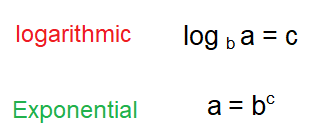FIND INVERSE OF LOGARITHMIC FUNCTION
Subscribe to our ▶️ YouTube channel 🔴 for the latest videos, updates, and tips.
If ƒ is a one-to-one function with domain D and range R, then the inverse function of ƒ, denoted by f-1, is the function with domain R and range D defined by
ƒ-1(b) = a if and only if ƒ(a) = b
To find inverse of a logarithmic function, we follow the steps given below.
Step 1 :
Replace f(x) by y.
Step 2 :
Derive the function for x.

Step 3 :
Replace x by f-1(x) and y by x.
Find the inverse of each of the following functions.
Example 1 :
f(x) = log2(x-3) - 5
Solution :
Example 2 :
f(x) = 3log3(x+3) + 1
Solution :
Example 3 :
f(x) = -2 log 2(x - 1) + 2
Solution :
Example 4 :
f(x) = -ln(1 - 2x) + 1
Solution :
Example 5 :
f(x) = 2x - 3
Solution :
Let y = f(x)
y = 2x - 3
Add 3 on both sides
y + 3 = 2x
log2(y + 3) = x
f-1(x) = log2(x + 3)
Example 6 :
f(x) = 2 ⋅33x - 1
Solution :
Example 7 :
f(x) = -5 ⋅ex + 2
Solution :
y = -5 ⋅ex + 2
y - 2 = -5 ⋅ex
2 - y = 5ex
(2 - y)/5 = ex
x = ln [(2 - y)/5]
f-1(x) = ln [(2 - x)/5]
Example 8 :
f(x) = 1 - 2 ⋅e-2x
Solution :
y = 1 - 2 ⋅e-2x
2 ⋅e-2x = 1 - y
e-2x = (1 - y)/2
-2x = ln [(1 - y)/2]
x = (-1/2) ln [(1 - y)/2]
f-1(x) = (-1/2) ln [(1 - x)/2]
Subscribe to our ▶️ YouTube channel 🔴 for the latest videos, updates, and tips.
Recent Articles
-
Finding Range of Values Inequality Problems
May 21, 24 08:51 PM
Finding Range of Values Inequality Problems -
Solving Two Step Inequality Word Problems
May 21, 24 08:51 AM
Solving Two Step Inequality Word Problems -
Exponential Function Context and Data Modeling
May 20, 24 10:45 PM
Exponential Function Context and Data Modeling